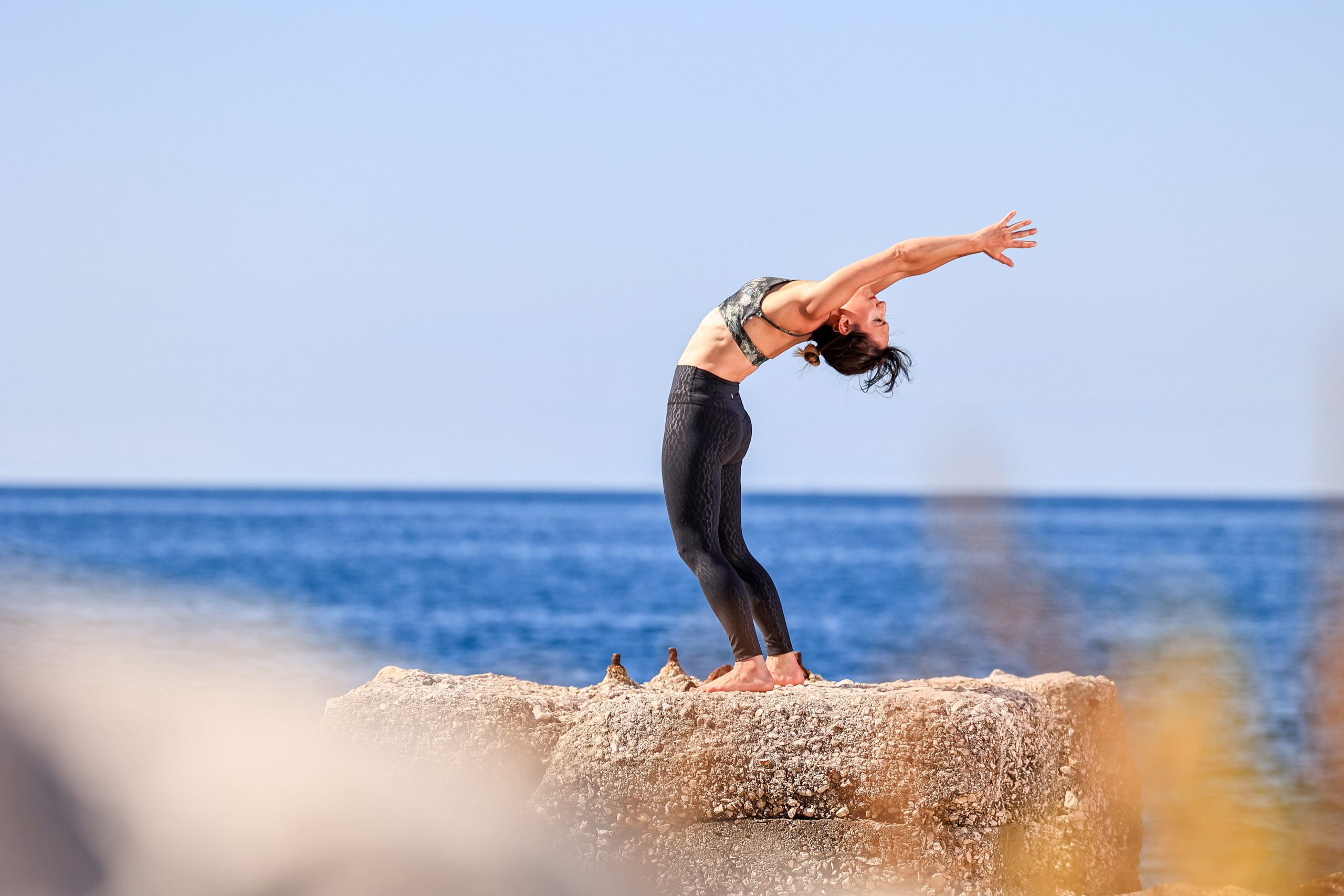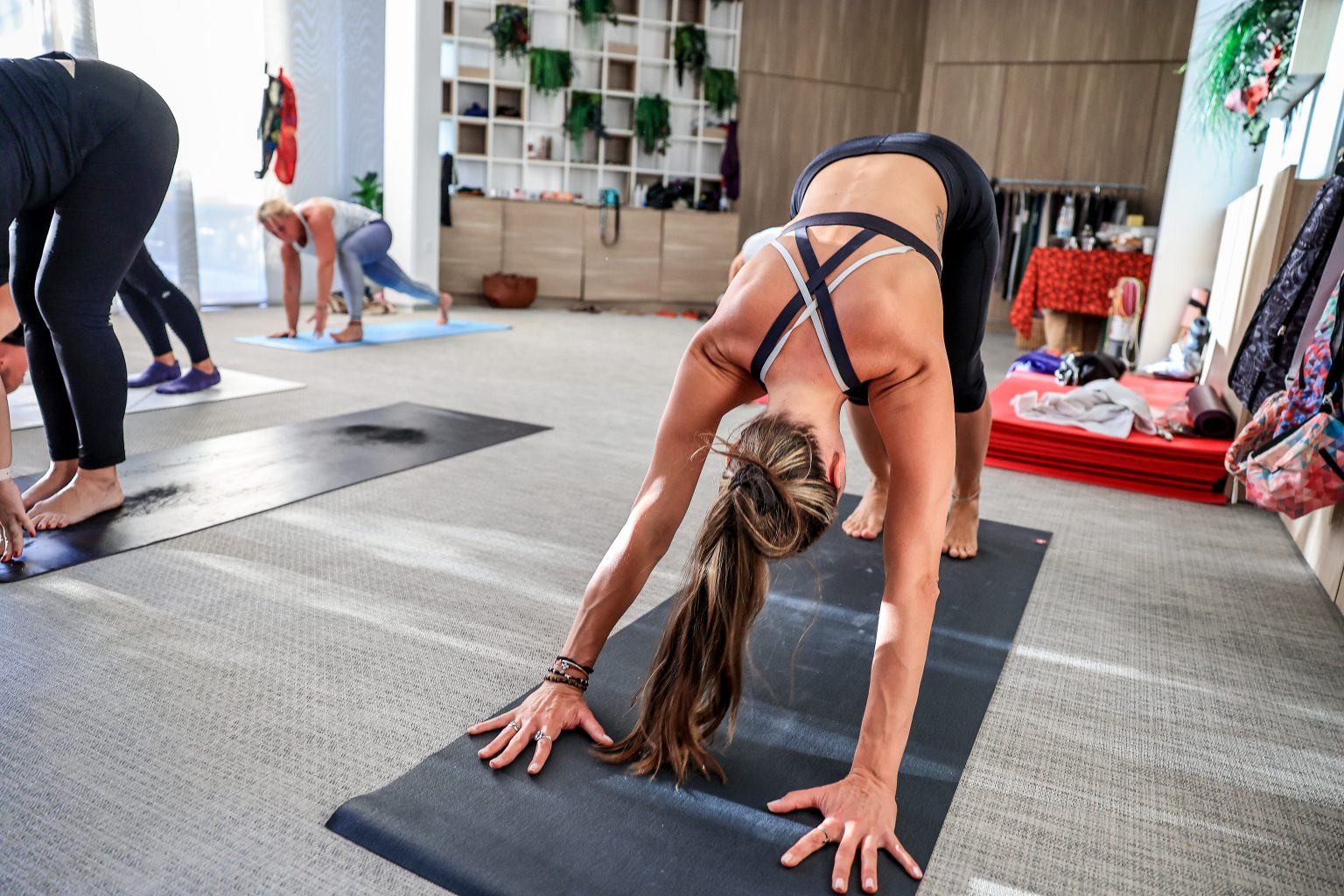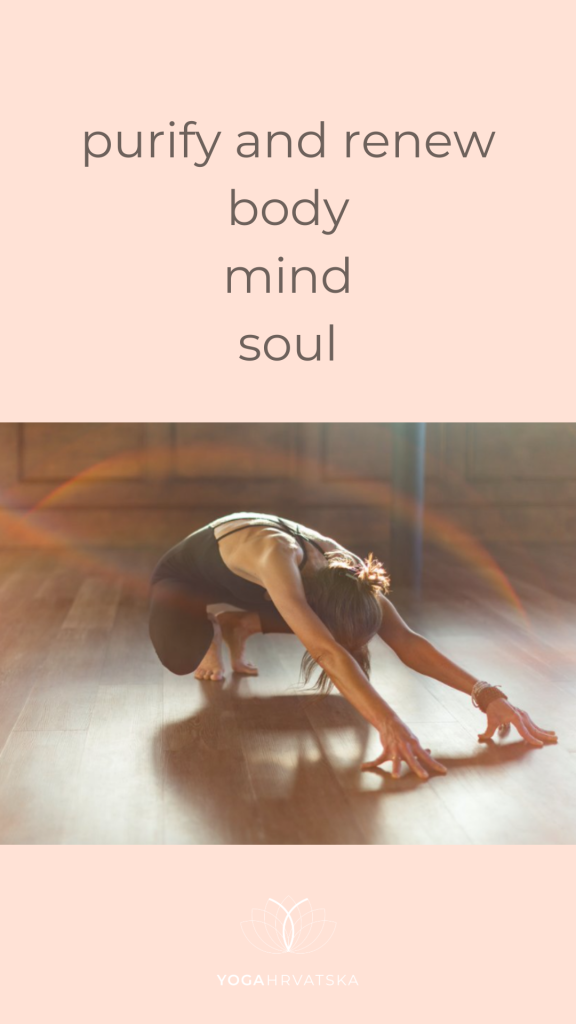
Photo by Tit Košir
WHAT'S SO SPECIAL IN ASHTANGA?
“The practice of asanas and pranayama is learning to control the body and the senses so the Inner light may come forth. That light is the same for the whole world and it is possible for man to experience this light, his own Self through correct Yoga practice.”
– Sri K. Pattabhi Jois
Let’s say that Ashtanga’s practice with eight limbs of yoga is, in fact, really challenging. First, you need at least 90 minutes, six-day a week, on-mat sessions. Then some specific nutrition and lifestyle modifications should appear as part of the practice which comes naturally along the practice.
If we relate to anything too literally, we can be in trouble. At this point, Ashtanga may be hard. The system means an idealised sequence to act as a blueprint or template for our efforts. If we think we must do this ideal sequence perfectly, it is seriously hard.
Anyhow, yoga is done for everyone and Ashtanga; with a mindful approach and modification to full poses, it is made accessible even to the elderly. Healthy practice means finding the right balance between maintaining the framework of the method and adapting to personal needs. If we throw out too much of the structure, it’s no longer Ashtanga. On the other hand, if we just remove what is challenging, we end up just doing what comes easily.
On the other side of the coin is blindly following and adhering too closely to the “rules”, neglecting each student’s peculiarities (age, amount of time for daily practice, constitution, past injuries, etc.).
So, where is the line which balances the benefits of the structure with the specific situation of each practitioner?
Through the years, with more practice, something more wants to be born. I find this exciting. I feel through yoga practice we uncover gifts, and it’s our responsibility to bring it forward or else grow stagnant. In many ways, it’s an offering. Our service to the world. Opening up to this there’s a sense of release, and at the same time, a comfort in not knowing it all. When I’m here I like to keep my eyes and ears open as I tune into my awareness. Can I learn something new through my encounters? Can I be open and release all notions of knowing something. Because yoga doesn’t work through association alone and idle gossip. It never has. – Laruga Glaser
- BE READY TO FAIL
Ashtanga is made not to be easy and to face you with failings. That is a part of learning. Be strong; accept your flaws or failings, and go beyond them with acceptance and a smile. If you think of Yamas and apply them to the asana practice, you are on the right way. Be truthful, consistent, gentle, authentic, patient, kind to yourself and detached from the practice. Need help?
2. START SMALL AND BREAK IT DOWN
Some teachers might tell you to do only Sun Salutations for a month(s) until you do Standing or Seated Poses. The first series consists of Sun Salutation, Standing Poses, Seated Poses, and Closing Poses. If you need to do complete series, always finish with the closing asanas. Or, stay less in Ardha Baddha Padmottanasana as you feel your hips still tight, and you work on opening hips later in seated poses since Standing half-bound lotus comes so early in the series, and it can be challenging hip opening posture for beginners. In the forward fold, ease yourself by bending your knees to release your hamstrings.
3. LINK YOUR BREATH WITH A MOVE
Focus on tying breath with moving more than to asana itself. The breath links together a conscious and unconscious mind; it creates new inner spaces, it allows prana flow, it calms you down and supports your parasympatethic system. Always start with your breath and then add the move, your breath directs your moves.
According to long-term practitioners’ experiences it seems that giving attention and intention to working with the breath is having the effect of allowing you to breathe with ease in often challenging asanas.
As David Swenson said:
“It’s my basic belief, and the premise of my teaching is that all yoga comes back to the breath; otherwise, it’s simply just a gymnastic exercise. But, of course, if that were the case, the greatest yogis would be circus performers and gymnasts.”
4. Is it all about loud ujjayi
This is one of the most ingrained myths about Ashtanga yoga that Sharath often corrects at the conference. It’s NOT ujjayi breath in practice; it’s free breathing and not so loud your neighbour can hear…. in Mysore, it was a mat-to-mat with 5cm in between.
There needs to be more clarity about how to breathe during your yoga practice or in ashtanga. For example, you were probably instructed to breathe load ujjayi breath so your neighbour can hear you. Indeed, it’s not the sound that makes your ujjayi breathe but the restriction of the glottis. But, on the other hand, if you breathe so intensively, you might finish your hour-and-a-half practice a bit spacey or tense and high.
Here is a short read from Adam Keen’s blog, about his ideas on breathing and dilemmas through long years of practice.
5. FEEL YOUR BODY FIRST
Each body has a specific constitution from where your practice should start. You practice yoga to become your own teacher and learn to recognize your body’s needs for balanced functioning. Test your body limits, and go beyond, but don’t hurt yourself during that exploration. Always think of Ahimsa. Remember to be gentle to yourself yet willing to see the improvement. Some days you will feel better at mat some days you will give up due to various reasons, don’t reprove yourself and just come back to the mat as soon as obstacles are gone. In which case, there is nothing wrong with the believing and following a tradition, as well as, at times, deviating from its instruction when it is seen lacking.
Indeed, it is said in the Bhagavad Gita, that ‘yoga does not mean eating too much or eating too little, nor does it mean, sleeping too much or not enough’. Indeed, in another chapter Krishna says to Arjuna that those that ‘punish the body, punish me in the body’.
The experiment at the end of the day, is yours and your alone.
6. DO NOT COMPARE YOURSELF
Do not compare yourself with anyone. You follow your own path. If you think of Asteya or non-stealing, translating this observance to practice on the mat will help you find your authentic self-expression. You may need to accept that in some postures, your body goes harder than others, while others can slip in easily and gracefully. Be gentle with your body and love it as is with all its peculiarities. Ayurveda knowledge will always be helpful in understanding your body’s innate capabilities. Your Prakriti or your personal footprint (dosha) is unique, and practice can help you to bring it to the full potential of expression in tune with natural laws.
7. SURRENDER TO THE PROCESS
Many teachers say that the most challenging part of the practice is stepping onto your mat. And this is actually true. Ashtanga is physically demanding and a moving meditation that helps recharge and lifts us up. And so, with time, we learn to step onto our mat, surrender to the process and let the practice take us where we are meant to go that day. It is not rare that you step on the mat with one intention and veer from that planned road somewhere else.
Sometimes there are more powerful influences that we might not even understand. The cue? Watch nature and adapt to it. When it is cold outside, you will need more time to heat up the joints and muscles. It’s just biophysics.
8. DON'T PUSH TOO HARD

Don’t push too hard!
Be aware of your physical limits and challenge them.
The sad fact is that if we push our physical limits and force our body into any position it may not be ready for, we will most likely get injured.
Unfortunately, injuries are common for beginners as we learn our limits and range of motion. We gradually tap into our body’s natural intelligence and learn to lead our way to a consistent and healthy practice.
9. YOU BECOME AWARE OF MOON CYCLES
You will adjust your practice to the Moon cycles and avoid practice for the New and Full Moon.
Like all things of a watery nature (human beings are about 70% water), we are affected by the phases of the moon. The phases of the moon are determined by the moon’s relative position to the sun. Full moons occur when they are in opposition and new moons when they are in conjunction. Both sun and moon exert a gravitational pull on the earth. Their relative positions create different energetic experiences that can be compared to the breath cycle.
The full moon energy corresponds to the end of inhalation when the force of prana is greatest. This is an expansive, upward moving force that makes us feel energetic and emotional, but not well grounded.
The new moon energy corresponds to the end of exhalation when the force of apana is greatest. Apana is a contracting, downward moving force that makes us feel calm and grounded, but dense and disinclined towards physical exertion.
Practicing Ashtanga Yoga over time makes us more attuned to natural cycles. Observing moon days is one way to recognize and honor the rhythms of nature so we can live in greater harmony with it.
Source: Tim Miller | ashtangayogacenter.com
10. ASHTANGA IS A SELF PRACTICE
When you start with Mysore classes and once learned the postures, you can take your practice anywhere with you. People usually fall in love with ashtanga just because of the self-paced practice where you can be exactly where you are and progress at your own rate.
“Mysore is also deemed as supervised self practice where the āsanas (postures) are introduced and taught, one at a time, so the student can easily memorize the sequence with both confidence and comfort, ultimately building the skills to move through the practice in a way that instills a sense of empowerment, steadiness and calm. In class the student will advance at their own rate with the guidance of an experienced teacher. In turn, the Ashtanga yoga practice is offered to each individual student fully dependent on where they are the day they walk into class. Rest assure, there will always be guidance and support when needed and it is consistently our goal to meet the needs of each student the very best we can. It is our recommendation when first starting out that students commit to at least one month at a minimum of 3 times a week to accelerate and deepen the learning process. ” – Laruga Glaser

11. MOVING AT YOUR OWN PACE
We listen and follow our breath with a movement or equal duration. And so when doing the sun salutations, we inhale and raise our hands up; exhale and fold forward. We inhale and lengthen the spine, exhale, step back, lower to low plank, etc. Learning breathing techniques and managing our breathing can be subtle work. Making changes to our breathing can bring up all kinds of emotions, from uncomfortable to dizziness, and it may be awkward for somebody for many different reasons. The tissues themselves are tight, which restricts our ability to breathe easily if we are in a professional sport. When our moves are tuned with our breath new spaces will unfold.
12. YOGA IS LIFE LEARNING PROCESS
YOGA is a life-learning process developed in time with discipline. If you cannot practice 6 days, practice at least 2 times per week and stay consistent. If you have a positive experience with yoga, it is likely that you will learn yoga lifelong. Even if you stop for a while, you will restart in some time. The reasons behind dropping out from classes are usually accessibility, life situations, or cost. The practice itself, when taught well, is hard to say no to.
13. YOU WILL BECOME STRONGER AND FLEXIBLE
Take it easy and modify poses at first. But then, with time, your body will start to change. Your arms will become stronger thanks to all the chaturangas, and your hamstrings will lengthen thanks to all uttanasana.
Studies have indeed found that a consistent practice of Ashtanga yoga may improve strength, flexibility, mood, well-being, and overall health.
14. IT'S ALWAYS THE SAME
Some people object that it is the same boring practice all the time. And yet, you will encounter many differences every day you step on the mat.
And yes, we move through the same routine, yet how we feel about it during each practice is different, making it far from boring.
15. PRACTICE HELP RESILIENCE
Specifically, the movements, breath control, and meditative focus that happen in yoga positively affect our nervous system and help us recover easier from usual life misfortunes.
Research shows that yoga is associated with mood regulation, affect regulation, and emotional processing, positively impacting our overall ability to respond to stimuli in our life. Yoga also affects our movement control, balance, body awareness, and proprioception, positively affecting our functional movement in daily life.
16. ASHTANGA IS ALSO ADAPTABLE
And just like anything with a structure, think Ashtanga method; there are times to stick with the structure, and then there are times to make changes to it.
Based on some data across a well-represented range of experience levels among practitioners, most Ashtangis are not absolutely rigid in their daily practice. Instead, we practice flowing with the changes from day to day. On some days, we have less time or energy; on others, we feel great and fit. Those data say something positive about the Ashtanga practice: it can persist in everyday life. Is it still Ashtanga Method? Sorry, but others will know the answer better then me!

The full ashtanga system practiced with devotion leads to freedom within one’s heart.”
— K. Pattabhi Jois
Sources: @larugayoga.com @ashtangayogacenter.com @yoganatomy.com






NOW accepting applications for our retreats with leading teachers who has supported thousands of yogini on their journey.
Let be frank, men and women are exhausted, overworked, and stressed which is why we’re holding our special retreats for a full 7 days, for you to take some time for yourself, to learn, relax and reflect! Get deep inside to find new connections.
Apply NOW, and learn from the best!
Regardless, if you’re new to yoga or have been practicing for years, this is a great opportunity to meet like-minded people and share an experience of a lifetime! All levels are welcomed.
Join our international group of happy yogini in Croatia
RETREAT WITH LARUGA, Brač Island, 1-8 October 2023
WE RISE RADIANT AND RENEWED; BRAČ Island, 17-24 June 2023



CONNECT TO YOUR HIGHER SELF
The practices of yoga and meditation can help us know our higher self a bit better. Taking time to retreat helps us profoundly understand ourselves so we can have the life we dream of.
Our dreams can manifest from imagination into reality.
I invite you to bravely stand up to the parts of you that hold you back and go to that Retreat.
Your soul will thank you.







No comment yet, add your voice below!